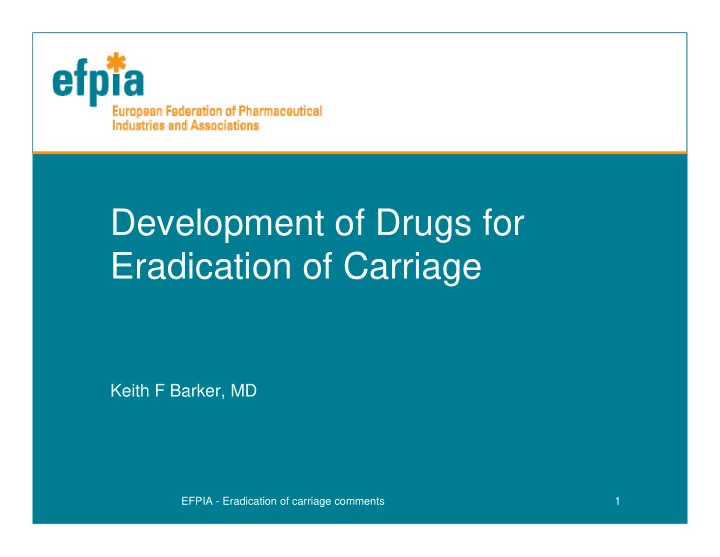

Development of Drugs for Eradication of Carriage Keith F Barker, MD EFPIA - Eradication of carriage comments 1
Eradication of carriage: Context • Nasal/gut: – S. aureus, N. meningitidis, H. pylori, C. difficile, gut flora (SDD) • Existing country labeling: – nasal mupirocin: S. aureus/ MRSA – oral ciprofloxacin/rifampicin: N. meningitidis – oral clarithromycin/amoxicillin/metronidazole: H. pylori • Regulatory focus going forward on proven clinical benefit over and above successful eradication (draft guideline 4.2.1.5.4) • Appropriate usage paramount in ‘prophylaxis’ setting 2 EFPIA - Eradication of carriage comments
What is eradication? • Reducing the bacterial load based on pre and post- therapy matched cultures – key focus: short-term highest risk periods or intermittent use in people with ongoing risk (dialysis) – not total eradication / not proven PCR negativity – makes most biological sense and is what has been linked with reduced infection rates – transient phenomenon - know that re-colonisation can occur 3 EFPIA - Eradication of carriage comments
Issues: S. aureus nasal eradication • Premise: S. aureus nasal carriage is an important risk factor for infection due to S. aureus 1,2 • Limited debate but conclusions from data in literature variable • Targeting patient population and/or intervention – surgical, dialysis, other high risk groups • Estimating placebo infection rates • Impact of evolving clinical & infection control practice on infection rates • Impact on surgical site infections only vs . all nosocomial infections • Applicability of rapid diagnostic testing for early carrier identification • Defining those at greatest risk & the unmet medical need 1. Munoz et al . J Hosp Inf 2008; 68: 25-31 4 2. Kluytmans et al . Infection 2005; 33: 3-8 EFPIA - Eradication of carriage comments
S. aureus nasal eradication Sample size for clinical benefit are in the thousands Total Number of Screening Subjects Scenario: 60% reduction 50% reduction 40% reduction 100,000 - 25% screened = nasal S.aureus carriers 90,000 - 2% placebo infection rate post-op 80,000 - objective: 50% reduction of infections 70,000 - 90% power, two-sided type-1 error 5% 60,000 50,000 → 26,400 subjects required 40,000 30,000 20,000 10,000 0 1% 2% 3% 4% 5% 6% 7% 8% 60% reduction 35,064 17,408 11,528 8,584 6,816 5,640 4,800 4,168 50% reduction 53,200 26,400 17,472 13,008 10,328 8,544 7,264 6,304 87,328 43,320 28,656 21,320 16,920 13,984 11,888 10,320 40% reduction Post-surgery infection rate in placebo group 5 EFPIA - Eradication of carriage comments
Impact: S. aureus nasal eradication • Accurately defining sample size problematic, but very likely that study subject numbers to prove clinical benefit in a highly defined population unmanageable → will be no new agent for S. aureus nasal eradication • As exogenous infection rates drop pre-op S. aureus colonisation is more relevant in serious, albeit increasingly rare, post-op infections • Control of S. aureus remains a challenge 6 EFPIA - Eradication of carriage comments
Summary • Fully support appropriate antibiotic use – preserve existing drugs, but, new drugs are needed (e.g. mupirocin resistance, emerging retapamulin resistance) • Nosocomial infections not solved by ‘best practice’ infection control alone • Insistence on demonstration of clear clinical benefit → unmanageable subject numbers • A need to rethink…. denying relevant microbiological endpoint is potentially depriving patients of new therapies 7 EFPIA - Eradication of carriage comments
Proposal • Can we validate well defined microbiological eradication to develop a surrogate variable as reliable predictor of clinical benefit? • How can industry work with academia and EMA to explore and define what it would take? – biological plausibility – prognostic value from existing epidemiology for the clinical outcome – clinical trial data 8 EFPIA - Eradication of carriage comments
Recommend
More recommend